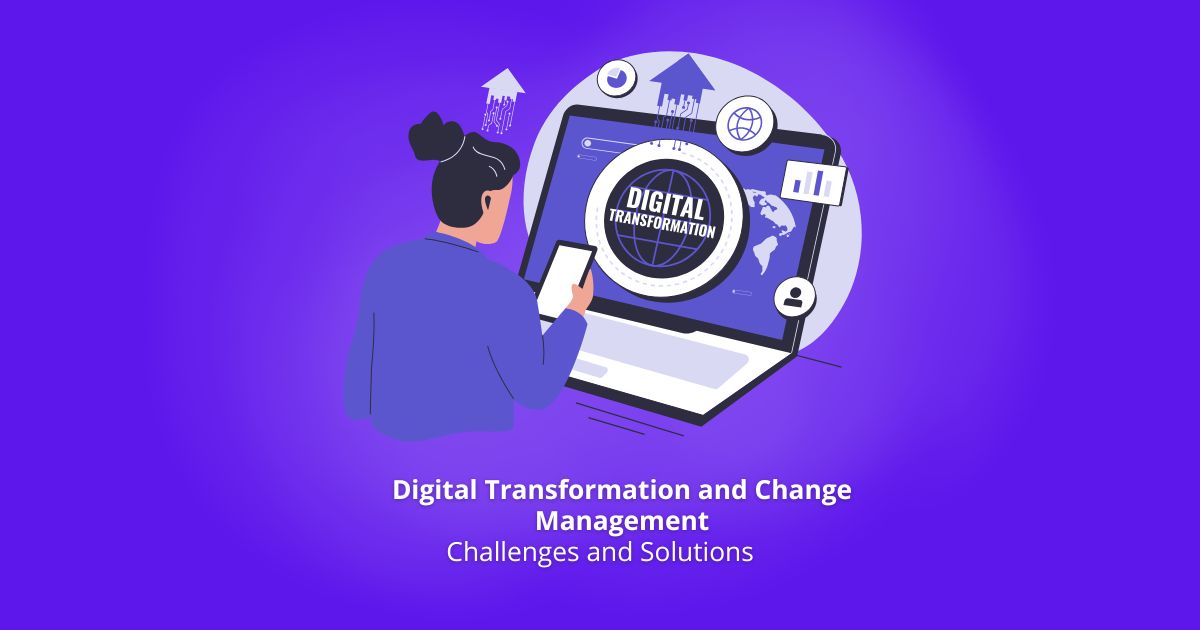Have you ever wondered why some businesses excel in digital transformation while others struggle to keep up?
In today’s rapidly evolving world, digital transformation is no longer a choice but a necessity for organizations to stay competitive. However, navigating this journey successfully requires more than just adopting new technologies—it demands effective change management.

This article delves into the common challenges businesses face during digital transformation and explores practical solutions to overcome them, ensuring a smoother transition and sustainable results.
Understanding Digital Transformation
Digital transformation refers to integrating digital technologies into all areas of an organization, fundamentally changing how it operates and delivers value to customers.
This shift impacts not just technology but also people, processes, and organizational culture.
It’s a holistic approach to modernizing operations and staying ahead in a technology-driven marketplace.
The Role of Change Management in Digital Transformation
Change management is the structured approach to managing the people side of change. It ensures employees at all levels adapt to new processes, technologies, and ways of working.
Without effective change management, digital transformation efforts can face resistance, delays, or even failure.
Key components of change management in digital transformation include:
- Clear Communication: Explaining the purpose and benefits of the change.
- Employee Involvement: Engaging teams early and often in the transition process.
- Leadership Support: Ensuring leaders actively advocate for and model the change.
Challenges in Digital Transformation and Change Management
1. Resistance to Change
Employees often resist changes due to fear of the unknown, concerns about job security, or skepticism about the benefits of new technologies. Resistance can hinder progress and create friction within teams.
Solution: Foster an open dialogue where employees can voice concerns. Providing consistent communication and training helps alleviate fears and builds trust.
2. Lack of Clear Vision
Without a clear strategy, digital transformation can become fragmented and aimless. Teams may not understand the overall goals or how their roles fit into the bigger picture.
Solution: Develop a roadmap that outlines objectives, milestones, and expected outcomes. Ensure that all departments understand their roles in achieving the vision.
3. Insufficient Training
Adopting new technologies often requires new skills, but insufficient training can leave employees feeling unprepared and overwhelmed.
Solution: Invest in comprehensive training programs that empower employees to use new tools confidently.
Consider enrolling your leadership team in a Seminar Change Management to equip them with the skills needed to guide their teams effectively through transitions.
4. Cultural Barriers
An organization’s culture may resist digital transformation, especially if it values traditional methods over innovation. A lack of alignment between culture and new processes can derail change efforts.
Solution: Gradually introduce cultural shifts that emphasize adaptability and innovation. Recognize and reward employees who embrace the change, setting a positive example for others.
5. Resource Constraints
Budget limitations, time constraints, or inadequate personnel can slow the pace of digital transformation. Organizations often underestimate the resources required for successful implementation.
Solution: Prioritize investments by focusing on changes with the highest impact. Break the transformation into manageable phases to align with available resources.
Solutions to Overcome Challenges
1. Engage Leadership at All Levels
Leaders play a critical role in change management. They must champion the transformation, actively communicate its benefits, and set an example for employees.
Tip: Host regular meetings where leaders share progress updates, address concerns, and celebrate wins to keep momentum strong.
2. Build a Change-Ready Workforce
Prepare your employees for ongoing transformation by fostering a culture of learning and resilience.
Action Steps:
- Offer continuous professional development opportunities.
- Implement feedback loops to improve processes based on employee input.
- Encourage collaboration across departments to break down silos.
3. Leverage Technology Strategically
Technology should serve as an enabler, not the sole focus, of digital transformation. Choose tools that align with your organization’s needs and goals.
Example: Automate repetitive tasks to free up employees for higher-value activities, enhancing productivity and job satisfaction.
4. Monitor Progress and Adapt
Regularly measure the impact of your digital transformation efforts to identify areas for improvement. Flexibility is key to adapting to unforeseen challenges.
Key Metrics:
- Employee adoption rates of new tools.
- Operational efficiency improvements.
- Customer satisfaction scores post-implementation.
Why Change Management is the Key to Success
Digital transformation is not just a technical challenge but a human one. Change management bridges the gap between innovation and implementation, ensuring employees are equipped and motivated to embrace new ways of working.
By addressing resistance, providing clear guidance, and fostering a supportive culture, businesses can unlock the full potential of their digital initiatives. Moreover especially when supported by platforms like agentforce that streamline the change process.
Conclusion
Digital transformation is a journey, not a destination. While the challenges may seem daunting, a robust change management strategy can pave the way for success.
By prioritizing communication, leadership, and employee engagement, organizations can navigate this transformative process with confidence.
Embracing change is no longer optional—it’s essential for survival in today’s fast-paced digital landscape. With the right approach, businesses can turn challenges into opportunities, ensuring long-term growth and innovation.